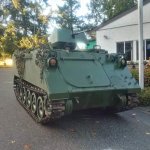Hello
> You'll note that I'm in NZ, not US. The museum I volunteer at is the Museum of Transport and Technology (MOTAT) in Auckland (
www.motat.org.nz ) where I manage the Military Section workshop.
I take it you are still located on that hill a couple of miles from the main MOTAT?
Yes. Meola Road aka MOTAT2
Many times as a kid we drove past the Sunderland and Sandringham sitting forlorn after they got marooned by the power lines.
I hope that Sunderland is under cover now?
Sandringam is actually a Solent. The last remaining one in the world and is now indoors. The Sunderland is outside still but undercover of shrink-wrap having corrosion removed from inside wings. Fuel tanks are removed.
> So, our 432 is used to give 'Tracked Vehicle Experience' rides to the civilian public
Using an FV-432 for that sort of thing would be high maintenance. I note that Bovvy run the pants off 2x M548 for their rides. Does make you
wonder why they don't use an FV series vehicle......................
Yes. We are used to the high level of running maintenance. It's very labour intensive.
> A lesser-experienced driver was behind the tillers...
In his defence, I would say that over undulating terrain, with civilian passengers on board, and keeping an eye
out for any trespassing children on the course, his vehicle awareness was probably a low priority.
Children not able to access running track but protected avian wildlife (Dotterils) are to be avoided at all costs.
> We are aware we drive it hard (But not fast) but have no knowlege of how it was driven when in service prior to arriving in our care.
Assume = flogged. It would be highly unusual for it to have been driven gently.
Correct. We do assume 'flogged'.
> Torsion Bars are best bought new so you know their history. We have one Port Side spare and will source another from UK.
I suggest you source more. Won't make make much difference to the price as freight and
import will not be cheap and won't go up much for a couple of more bars.
Yes. We have that in mind.
> If you ever come across the ditch do get in touch and pop-in. You're most welcome.
Most appreciated.
Dad's side of the family grew up in Birkedale,
(Birkenhead?) they then moved to Brown's Bay (Grandad was mayor of East Coast Bays at one time).
My uncle, in his 80s is still there.

Haven't been back over since 1996. We are looking at another trip over in the next year or 2.
Look forward to seeing you.
Regards
Doug


